

NAAC-Accredited 'A++' - Grade 2(f) & 12(B) status (UGC) |ISO
9001:2015 Certified | FIST Funded (DST) SIRO(DSIR)

Lab Facility
Lab Incharge
Teaching Staff : Dr. M. Senthilvadivu
Non Teaching Staff : Mr. J. Soundappan
Communication Engineering laboratory focuses on training the students in analog and digital transmission/reception of signals. The students start in the analog area by constructing the amplitude modulation, frequency modulation, and phase modulation circuits. They build a mini AM transmitter in the electromagnetic spectrum's microwave frequency and do a live transmission with minimum power output.
The signals are received in a pocket AM radio. Learning the concepts with small applications, gives them plenty of joy and real motivation towards their studies. The other important area of analog signal processing is the phase-locked loop. Students are given NE 565 PLL IC and made to conduct an experiment to find the capture and lock ranges with their designed specifications. Here, the students make use of function generators with frequency sweep facility.
The students are enlightened, yet in another area is audio systems, widely used to address the public. The students perform the characteristics of the microphone. So they gain knowledge in Acoustical Engineering. They also test condenser, coil, and piezoelectric transducers used in audio engineering. In pulse techniques, faculty help them in PAM and PWM experiments. In addition to all the above, the lab consists of the fiber optic trainer, analog signal sampling kit, TDM trainer, and microwave test benches.
Equipments :
- Function Generators and Cathode ray Oscilloscopes
- Audio Oscillator with Counter
- 150MHz RF Signal Generator
- Various Analog /Digital Study and Trainer Kits
- Fiber Optic Trainer Kit
- Digital Storage Oscilloscope with 1.0GHz sampling rate
- Network analyzer – E5061A-Agilent Technologies (300KHz ~ 1.5 GHz)
- Spectrum Analyzer – E4411B-Agilent Technologies (9 KHz ~ 1.5 GHz)
- Vector Signal Generator – E4438C- Agilent Technologies (250 KHz ~ 1 GHz)
- Data Acquisition/Switch unit - E54790A-Agilent Technologies
- EPM Series Power Meter-E4418B-Agilent Technologies.
- Microwave anechoic chamber – Falcon (4 ft * 4 ft –1 Pair)
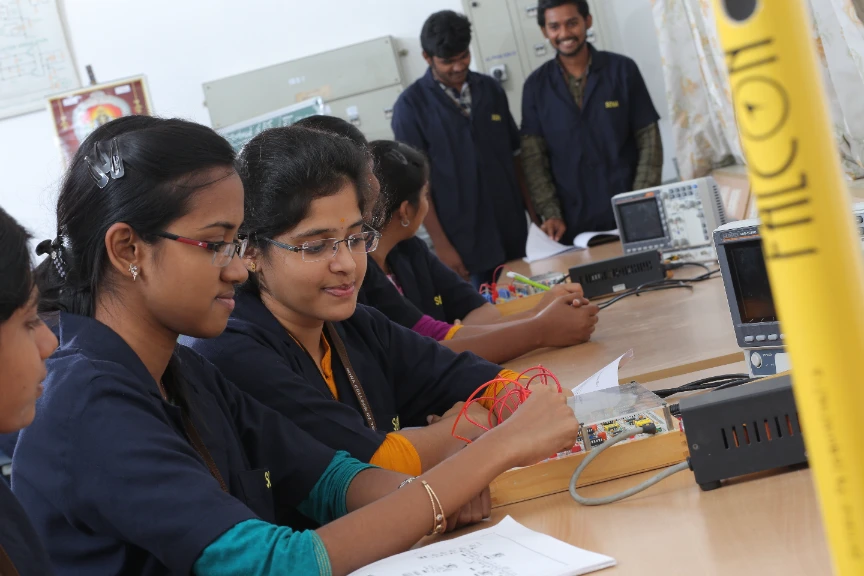 |

| 
|
Lab Incharge
Teaching Staff : Dr.K.Anguraj
Non Teaching Staff : Mr.V.Velu
The electronics lab is uniquely equipped with the latest signal generators, oscilloscopes, digital trainer kits, and measuring instruments. Students of various branches design and test their analog/digital/mixed signals digital circuits as part of their curriculum. Guidance is provided to the students by a team of expert faculty and lab technicians. The labs are kept open after college hours to enable the students to engage themselves in designing/testing the circuits in their leisure hours. Students are grouped into small teams and guided to do their mini-projects using the facility mentioned below. The R&D activities were also carried out in the electronics lab.
- Cathode Ray Oscilloscope
- Function Generator
- Dual Power Supplies
- DMM with RS232
- Wide Range of Analog Meters
- Digital Multi-meters.
- Analog and Digital IC Testers
- LCR Meters
- Various Types and ranges of Active and Passive components
- Soldiering Irons.
- Digital Trainers
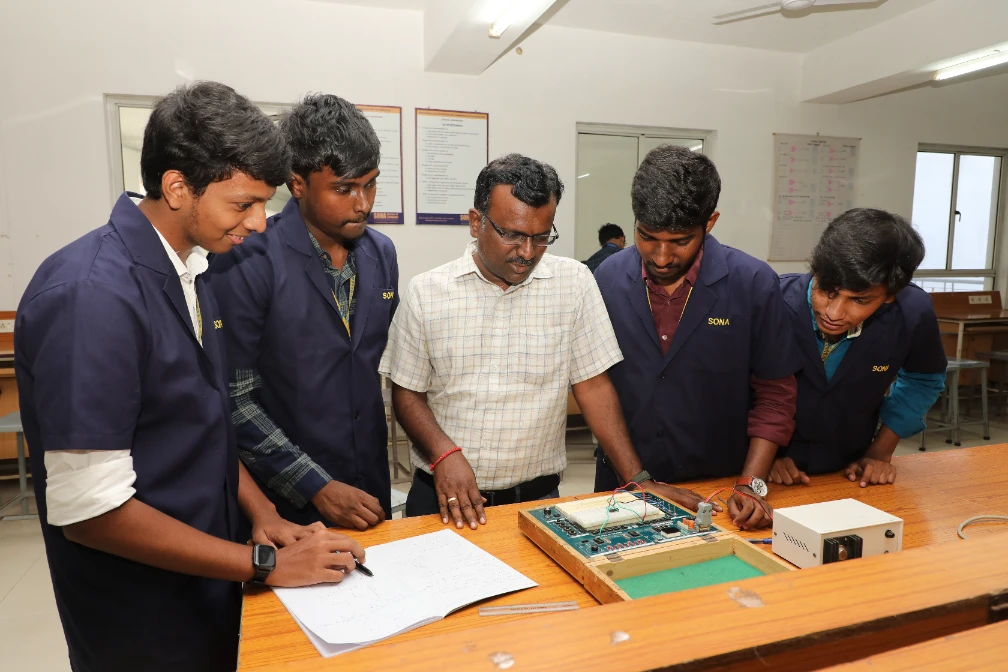 |
 |
Lab Incharge
Teaching Staff : Dr.S.VijayaLakshmi
Non Teaching Staff : Mr. C.Kumaresan
The Microprocessor lab is a dedicated space where students can gain practical experience and hands-on training in working with microprocessors. In this lab, students will learn about microprocessors' architecture, functionality, and programming. They can work with different microprocessor models and learn to interface them with various peripherals and devices.
The lab has the necessary hardware and software tools, including microprocessor development boards, programming software, and debugging tools. Students will learn to write and debug code for microprocessors using programming languages. Students will develop their skills in designing and implementing microprocessor-based systems through practical exercises and projects. They will learn how to program microprocessors to perform tasks such as data processing, control external devices, and communicate with other systems. The Microprocessor lab provides a hands-on learning experience that complements theoretical knowledge and helps students understand the practical aspects of working with microprocessors. It prepares them for careers in embedded systems, digital design, and other fields that involve microprocessor-based systems.
- Intel 8085, 8086/8088, Z 80, MC 6800 Microprocessor kits
- 8051 Micro Controller kits with PC Interface
- PIC Processor
- ARM Processor
- Interfacing Cards
 |
 |
Lab Incharge
Teaching Staff : Dr. M. Jamunarani
Non Teaching Staff : Mr.P.Krishnamoorthi
In Microwave Lab, the students are exposed to microwave active devices like Klystron, Gunn diode and passive devices isolator, circulator, slide screw tuner, magic tee, directional coupler, horn antenna, attenuator, and terminations. The students perform all the experiments as prescribed by the university. The optical communication laboratory is set up to complement the topics studied in the optical communication theory course. The lab is equipped with fiber optic trainer kits and modules to enable the study of components of an optical communication system.
The students perform experiments to study the characteristics of optical sources (LED & LD), optical detectors (LD & APD), and optical fibers. Fault detection in a fiber link is studied using the OTDR module. An FSO module enables the study of optical signal transmission in free space. The lab is equipped with Connecterization and splicing kits.
- Klystron Bench
- Gunn Bench
- Various Passive Components
- Optical Fiber Trainer Kits
- Optical Source (LED & LD)
- Optical detector (PD & APD)
- Power Meter
- OTDR Building Block
- Video link with Transmitter
- Glass & Plastic Fiber
- Connecterization and Splicing kits
- Single Mode Fibre Characteristics Study Setup, add on to existing OFS

Lab Incharge
Teaching Staff : Dr.K.R.Kavitha
Non Teaching Staff : Mr. J. Soundappan
Digital Signal Processing is becoming more prevalent in everyday use. The field of DSP is developed due to the flexibility digital computers offer in implementing signal processing algorithms. The DSP Lab is based on MATLAB Software which is used for identifying and describing discrete and digital signals & systems. This lab also helps us analyze how digital signals differ from analog counterparts. A digital signal processor (DSP) is a specialized microprocessor chip, with its architecture optimized for the operational needs of digital signal processing. The DSP is equipped with hordes of personal computers and Digital Signal Processors. The students enrich their knowledge using the software tools and the DSP Processors.
List of Equipments
- Texas Instruments DSP ProcessorTMS320C5416
- DSP ProcessorTMS320F28377
- DSP ProcessorTMS320C6748
- I5 Processor Computers
- Digital Storage Oscilloscope 60Mhz
SOFTWARE TOOLS
- MATLAB V 9.12 (R2023b) with various toolboxes.
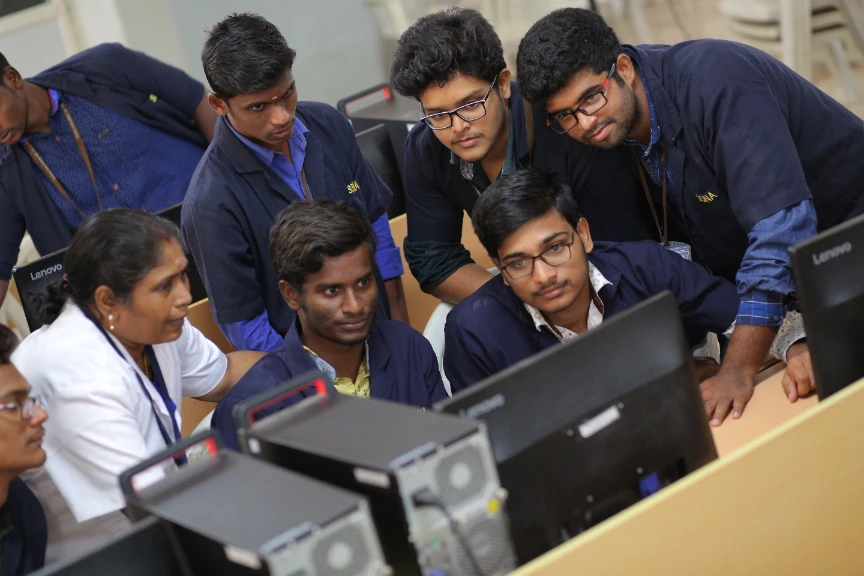 |
 |
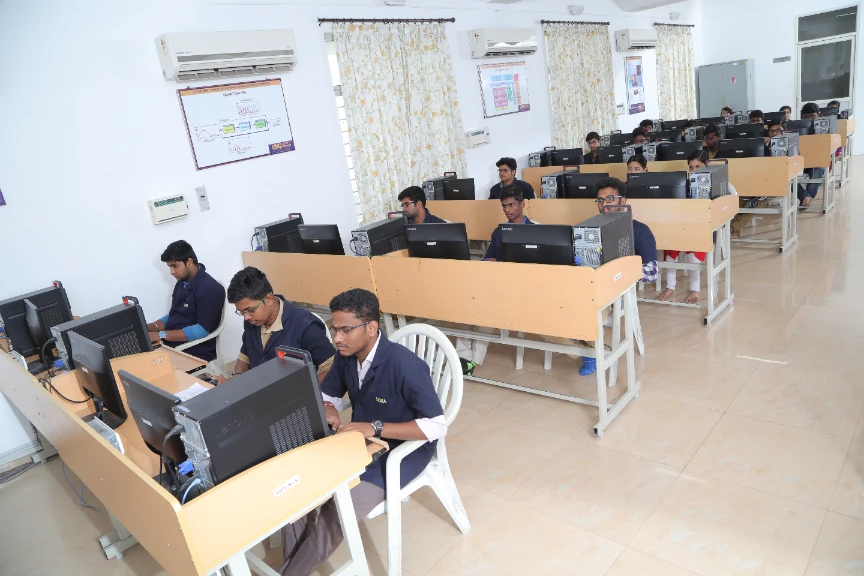 |
Lab Incharge
Teaching Staff : Prof. J. Harirajkumar.
Non Teaching Staff : Mr. B. Balaji.
VLSI Lab focuses on designing small and large-Scale Integration. It creates integrated circuits (ICs) by combining thousands or millions of transistors onto a single chip. It involves developing and fabricating complex electronic systems that perform various functions, such as processing, memory, and communication.
Front-End Design
The front-end design stage of VLSI Design involves digital design using hardware description languages (HDLs) such as Verilog, System Verilog, and VHDL. This stage includes designing the digital logic circuits and verifying their functionality through simulation and other verification techniques. It also includes designing for testability, ensuring that the circuits can be effectively tested for defects.Back-End Design
The back-end design stage of VLSI Design focuses on the physical implementation of the circuits. It includes characterization and CMOS (Complementary Metal-Oxide-Semiconductor) library design. This stage also involves fault simulation to ensure the courses can tolerate faults and physical design, which includes placement and routing of the components on the chip.
VLSI Design is a multidisciplinary field combining digital design, circuit design, and physical design to create highly integrated and efficient electronic systems. It is crucial in advancing technology and enabling various applications in different industries.
TOOLS & EQUIPMENTS:
VLSI SOFTWARE TOOLS
- SIEIMENS EDA - Mentor Graphics
- AMD -Xilinx Tool
- Intel FPGA - Quartus Tool
COMPUTING SYSTEM
- Lenovo i7 Processor ,8 GB Ram Systems
FPGA BOARDS
- Altera Development & Education Board (DE0)
- AlteraDevelopment & Education Board (DE1)
- AlteraDevelopment & Education Board (DE2)
- FPGA Base station
- Add on Boards (ADC/DAC, Stepper Motor, LED Matrix,
- USB 2.0 Device Controller, Audio CODEC, Ethernet, IR)
- Logic Analyzer
- Digipat
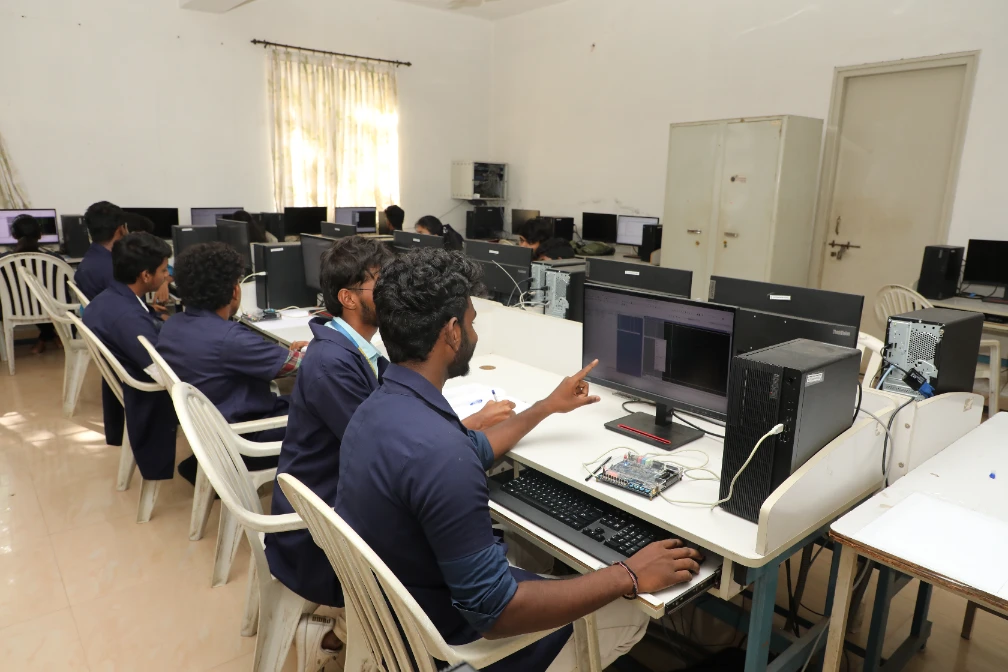

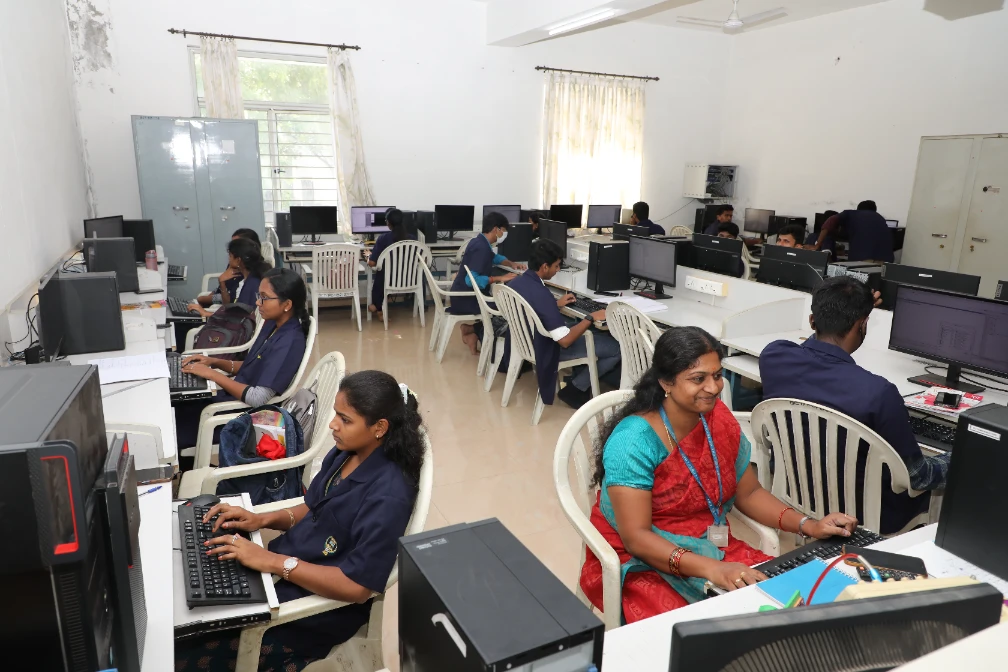
Lab Incharge
Teaching Staff : Dr. G. Ravi.
Non Teaching Staff : Mr. R. Yuvaraj.
Linear Integrated Circuits & Simulation lab is essential for designing the characteristics of OP-AMP,555 Timer IC and to simulate the applications of OP-AMP. It is also used for designing the Electronic circuits-1. Students of various branches design and test their circuits as part of their curriculum. Guidance is provided to the students by expert faculty and lab technicians. The labs are kept open after college hours to enable the students to engage themselves in designing /testing the circuits in their leisure hours. Students are grouped into small teams and guided to do their mini-projects using the facility mentioned below.
Equipments:
- Cathode Ray Oscilloscope
- Function Generator
- Dual Power Supplies
- Digital Multimeter

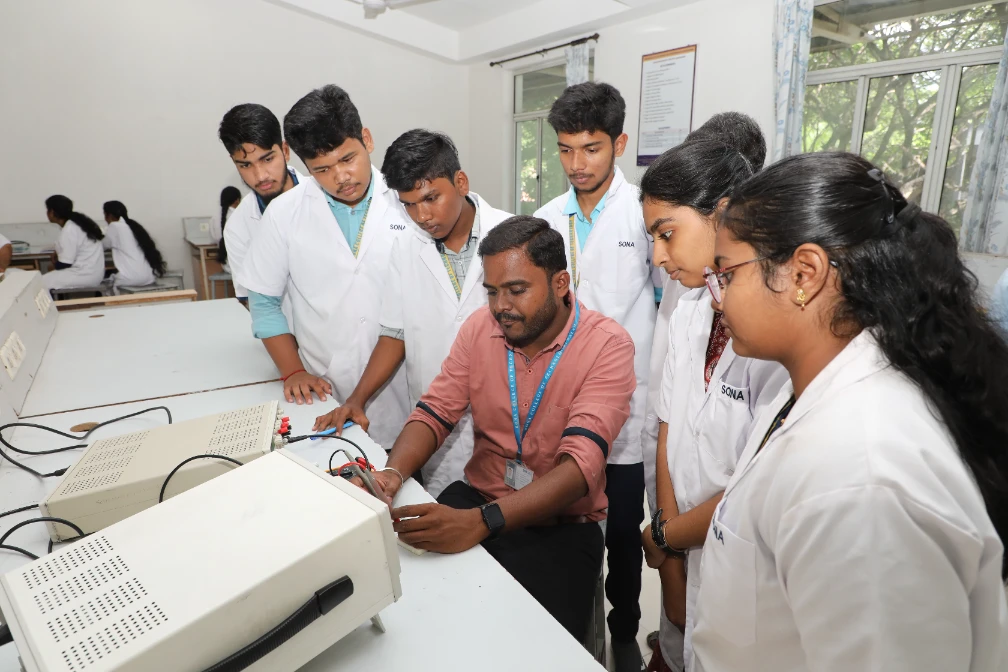
Lab Incharge
Teaching Staff : Dr. B.Thiyaneswaran, Prof. A. P. Jayakrishna.
Non Teaching Staff : Mr. P. Selvakumar.
The embedded system lab provides many facilities to design and develop embedded and IoT applications. The lab has a wide range of sensors, processors and microcontroller boards. The Embedded 'C' based programs are taught in the laboratory session. The experiments started with a basic LED, key switch, 7-segment LCD, and a wide range of sensors interfacing. Various connectivity, such as IR, Bluetooth, WiFi (ESP8266), etc, are used in experiments. The Embedded Systems lab supports teaching and research on embedded & IOT platforms. It is an industry-supported laboratory. The various types of apparatus are used in the laboratory, such as Texas Instruments, Intel, etc. The lab supports students' projects, Hackathon events, and research studies. The lab is equipped with a computing facility with major IDE facilities. The (Sensathon'22 and Sensathon'23) sensors Hackathon series are conducted in the embedded system lab.
Equipments and Tools :
- Arduino UNO, Nano, NodeMCU.
- Raspberry PI
- Intel Boards.
- Sensors Kits.
- Microcontroller Ultra-Low Power MSP430 MSP-EXP430F5438
- Tiva C Series Development Board DK-TM4C123G
- DSP TMS320C6748 with emulator
- MSP 430 EXP G2 Launch Pad
- MSP 430F5529
- Educational Booster Pack MKII
- C2000 Piccolo LAUNCHXL-F28027
- TIVA Launch pad EK-TM4C123GXL
- Wi-Fi® Booster Pack CC3100
- CC3200 Simple Link WiFi Launch Pad
- CC2650 Sensor Tag
- TM4C129E Crypto Connected IoT Gateway Launch Pad
- FireBird V 2560
- Spark V Robot
- FireBird V LPC2148 adapter card
- Zigbee Modules 100m range
- Zigbee Modules Adapter
- AVRISP mkII USB Programmer
- Two Axis Camera pod with Wireless Camera
- USB TV Tuner for Interfacing wireless camera with Laptop
- Kineet (Xbox) Sensor
- Android Device (Samsung Galaxy Star Pro)
- Metal – gear Servo Motors
- Sharp GP 2D120C infrared range sensor (4cm to 30cm)
- Sharp GP 2Y0A2YK infrared range sensor (20cm to 150cm)
- Sharp GP 2Y0A710K0F infrared range sensor (100cm to 500cm)
- Maxbotix ultrasonic range sensor
- L3G4200 a axis digital gyroscope
- LSM303 3 axis digital accelerometer and 3 axis magnetometer
- GPS receiver
- Gyroscope, accelerometer and GPS interfacing module for the robot
- Servo Motor Based Gripper kit for the Fire Bird V robot
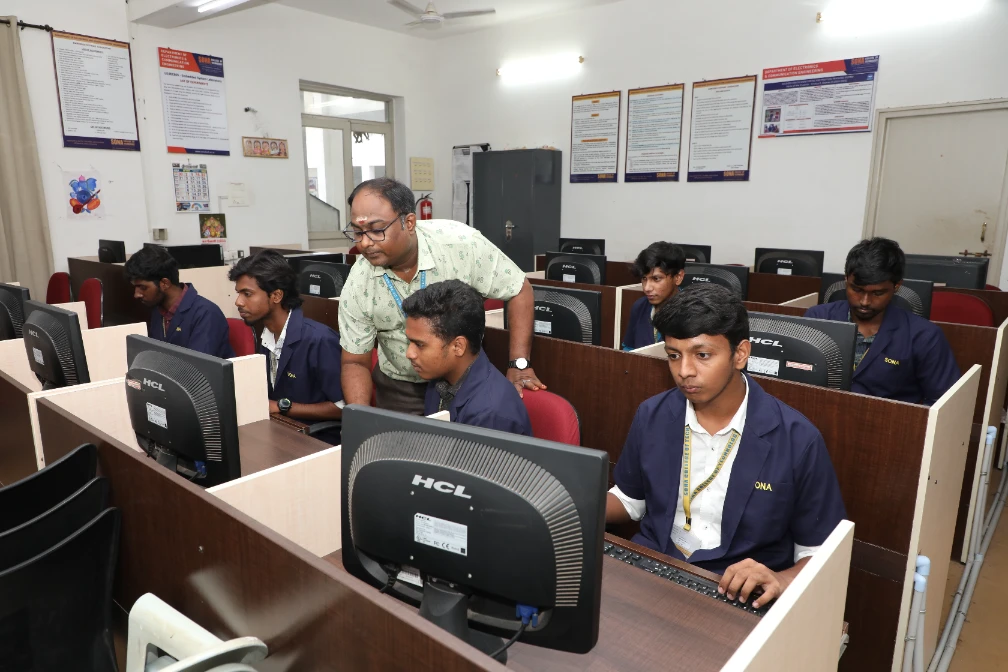
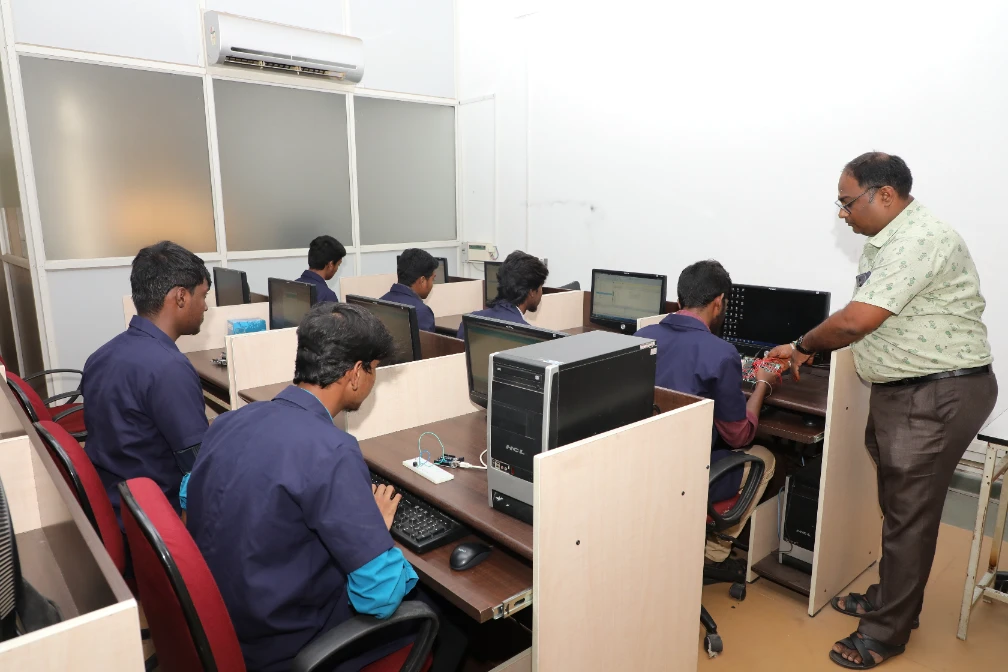
Lab Incharge
Teaching Staff : Dr. P. M. Dinesh.
Non Teaching Staff: Ms. S. Dhanalakshmi & Ms. Rajalakshmi.
Digital Image Processing Lab is committed to building upon its excellent talent and facility bases to pursue new applied research and development (R&D) opportunities.
Agreement between theory and experiment leads to knowledge, whereas disagreement between the two leads to research that further shows knowledge. The knowledge accrued through the confluence of theory and experiment becomes an input for many applications.
Our vision includes a research component for undergraduate students as well, as we see quality research as the foundation of any academic program.
This lab includes NI Lab View, DAQ Unit, and Smart Camera.
It caters to the processing of image fundamentals, image enhancement, image restoration, image segmentation, image compression, and various image transforms.
 |
 |
Lab Incharge
Teaching Staff : Dr. N. Sasirekha
Non Teaching Staff : Mr. T. Karthik.
Hardware Tools :
- PIC16F877A demo boards
- 5Million SPARTAN-3 Boards with XC3S500 P.G.900 FPGA on board for advanced research
- DSP-in-VLSI Trainer kits (Xilinx FPGA-SPARTAN)
- 4. DSPIC 16 bit Microcontroller kits
- AVR Microcontroller Boards
- DSP Starter Kit TMS 320C6713
- Link B Advanced Fiber Optic Communication Traniner Kit
- Fiber Optic Link with CCD Cemera Monitor & Fiber optic Link
- ATS -03 (850Mhz) Antenna tranning System with GPS Traner Kit
Software Tools :
- MATLAB with tool boxes
- Code composer studio 3.1 version
- Xilinx ISE series 8.1i
- Altera – Quartus II 6.1
- VHDL & verilog – Modelsim simulator
- Mikro C compiler for PIC v.5
- Network simulator ns – 2